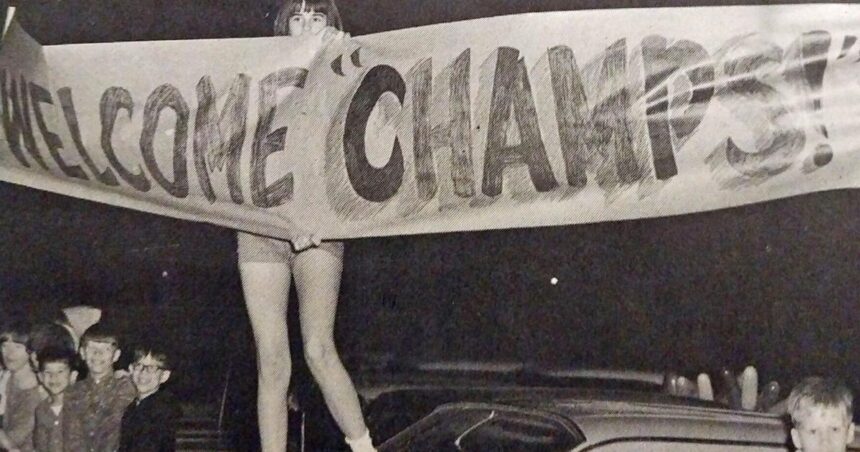WOLF POINT —It only lasted six years, from 1963-1969, but memories of The Big 32 reverberate across Montana with an unexplainable lifeforce.
At times it blossomed into a wild west variety show, a carnival in living color, an assortment of teams.
The Wolf Point basketball team receives a hero’s welcome on the Fort Peck Indian Reservation after winning the 1968 Big 32 crown.
The Weeks brothers, John and Willie, from their little Fort Peck Indian Reservation town of Wolf Point, added charm to the folklore.
It was officially dubbed Class A basketball but was called the Big 32 Conference, with the largest 32 Class A and AA institutions quartered into four divisions.
There were many reasons for its inception, but one was to increase the diversity of competition.
For Montana, “It was the best overall quality of basketball ever,” says Jim Haugen, former executive director of the Montana High School Association.
People are also reading…
To arrive at the even 32 teams, some Class B schools would have to be bumped up to Class A in all sports.
A few, such as Cut Bank, resisted. Others, including eventual 1966 champion Libby, Columbia Falls and 1968 champion Wolf Point, embraced it. These schools, along with a few others, would rise from B to A.
Cut Bank fell into the 400-plus range of minimum enrollment requirement for the Big 32. But the school appealed, and remained in Class B. Why? To move to Class A would force monstrous football travel requirements to Libby, Whitefish and Columbia Falls as well as Deer Lodge and Dillon.
The top two Big 32 teams from each divisional tourney would advance to “the final eight tournament” at either Butte’s concrete Civic Center or MSU’s fieldhouse — the only venues that could handle the locust swarms of Montanans attending.
The 1969 tournament broke all attendance records. For the semifinals on a Friday, 10,700 witnessed Kalispell Flathead edge Great Falls CMR 73-72 and undefeated Laurel top Butte Central 63-56, eclipsing the fieldhouse mark of 10,200 set a decade earlier when Elgin Baylor’s Seattle University squad faced MSU.
When Laurel foiled Flathead 59-56 the following night for the final crown, 10,700 showed again. Another 500 were denied.
The two nights of 10,700 fans remain the largest crowds ever to witness high school basketball games in Montana.
For the initial 1963-64 season, the league was actually the Big 30, with the plan to expand to 32 teams. The following year, Missoula County High split in two — Hellgate and Sentinel — thus, the Big 31. When Great Falls CMR entered for the 1965-66 interlude, the four divisions were now complete with eight teams each — and God Bless Montana’s Big 32.
In the early years of the Big 32, the largest schools were Missoula County and Great Falls, both hovering around 3,000 students before they both calved into two additional schools each.
Some reports had Great Falls at 3,740, and still growing. It must be noted that reported enrollment numbers are inconsistent, at best. Some newspapers only totaled grades 10-12, but Montana’s policy was based on four grades.
When Laurel won the Big 32 in 1969, some reports had the school at 450 students when it was closer to 560 (including the freshmen from the junior high were included). Interestingly, a 1963 Laurel Outlook story pined against the Big 32, claiming that it was “preposterous” based on geography and politics, noting that the Great Falls and Billings schools would not play their parochial crosstown counterparts.
Another note: when Great Falls and Missoula split into two schools each, all four continued to balloon in enrollment during this Baby Boom era.
For the last year of the Big 32 state tournament in 1969, Great Falls CMR was the largest school with 2,363 students and Wolf Point the smallest at 458.
The two smallest schools over the six-year span were Helena Cathedral, soon to be redesignated Helena Central, and Anaconda Central. They had about 350 students each, and sometimes much less.
Still, no team was a punching bag in the Big 32. Every school put up resistance, delivering body blows.
And no small school hit more ferociously than Wolf Point, with its special provocateurs, Big John and Willie Weeks.
The league became prestigious, with a continuous rinse cycle of nonstop stellar competition. The wee institutions were honored to be in “the best basketball league ever,” as former Sidney Eagles and hall of fame coach Dick Norden remembers it.
Large schools were wary of falling to the Helena Cathedral Greenies, Whitefish Bulldogs and Anaconda Central Saints. Whether just down the valley or 300 miles across the Great Divide, from opening tipoff, regardless of size, any school knew they could be gagging for air.
It was the only time the MHSA did the scheduling of basketball games, slating about 80% for the Big 32 teams. Remaining schedule vacancies were left up to the schools.
Before the season, each institution requested who they wanted to play, but it was never guaranteed.
As powerful as they were, Billings West and Billing Senior were watchful of scheduling. Over the years, they noticed that Wolf Point had been a Great Falls Bison irritant. They knew Butte native Bill Salonen coached the Glasgow Scotties and was willing to hop in cars, cross the gravel roads of the Missouri Breaks, and play the Broncs and Golden Bears in Billings any time.
Tiny Hardin, 47 miles away from Billings, was dangerous. A game between Senior and the Bulldogs was never scheduled in the six years of the Big 32. West and Hardin finally played two games, once in 1967-1968, and again for the 1968-1969 season. West won both but, then again, was supposed to, right?
And to travel down I-94 to Miles City, Glendive or Sidney? Well, whether they were victorious or not, the sizeable schools could not win the propaganda wars.
For many fans, there was the hope that, on any given night, microscopic schools such as Hamilton, Deer Lodge or Dillon could bring down Helena, Kalispell Flathead or mighty Butte.
Regardless of enrollment, it was an unrelenting whack-a-mole for each Big 32 team. They needed to be ready, regardless of size, tradition or competitive speculation. The gloves were off before entering the ring, for many reasons.
“Senior and West had strong teams,” Norden recalled of the early Big 32 days. “Mike Welton (West) was the best I played against. And (laughing) big Pete Lazetich (Senior) – I saw him pop a basketball on the first dribble. Or, was it the second?”
Mike Lewis of Missoula County would play several years in the ABA and Laurel’s Tom Perrigo and Ron Johnson and Hardin’s Gayle Three Irons were a hex for any team.
Jim Meredith of Anaconda Central, a 6-7 center, was revered by rivals Anaconda, Butte and Butte Central. Pat Donovan of Helena Central and, later, Helena High (when Central closed) was not only a three-sport all-stater but also a two-sport All-American.
What a time in Montana history.
The state’s papers splattered bright, flaming ink: “And in Big 32 action last night …”
The 1969 Trainmen of Laurel swiped the last Big 32 crown undefeated, leaving the other 31 teams with vertigo.
Total attendance for that final three-day tournament: 41,000.
The next year, the league vanished into a Big 16 and Little 16 format. It was never the same. Lower attendance, some insipid games, electricity shorted out.
Some said the larger schools feared losing to the smaller squads, which wasn’t unfounded given Class A programs Libby, Wolf Point and Laurel won three of the six Big 32 titles. Some smaller schools were opposed anyway because felt they had little chance at titles.
The Big 32 mystique remains.
Could it happen again? Yes, if the schools voted for it.
Wade Reynolds, who played for strong Laurel Locomotive basketball teams in the 1990s, said his teammates always wished they could have had a shot at larger schools. The football Shrine Gamer mentioned a legendary Great Falls team specifically.





